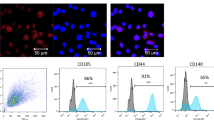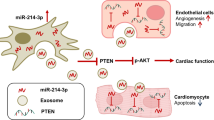Abstract
We demonstrated the effects of exosomes secreted by cardiac mesenchymal stem cells (C-MSC-Exo) in protecting acute ischemic myocardium from reperfusion injury. To investigate the effect of exosomes from C-MSC on angiogenesis, we injected C-MSC-Exo or PBS intramuscularly into ischemic hind limb. Blood perfusion of limb was evaluated by laser Doppler Imaging. We observed that ischemic limb treated with C-MSC-Exo exhibits improved blood perfusion compared to ischemic limb treated with PBS at 2 weeks and 1 month after induction of limb ischemia. To explore the potential mechanisms underlying C-MSC-Exo’s angiogenetic effect, we performed microRNA array analysis and identify mmu-miR-7116-5p as the most abundant enriched miRNA detected in C-MSC-Exo. Bioinformatics’ analysis shows that miR-7116-5p negatively regulates protein polyubiquitination. In conclusion, our study demonstrated that intramuscular delivery of C-MSC-Exo after limb ischemia improves blood perfusion, and we identified the most abundant miRNAs that are preferentially enriched in C-MSC-Exo.





Similar content being viewed by others
References
Gaziano, T. A., Bitton, A., Anand, S., Abrahams-Gessel, S., & Murphy, A. (2010). Growing epidemic of coronary heart disease in low- and middle-income countries. Current Problems in Cardiology, 35, 72–115. https://doi.org/10.1016/j.cpcardiol.2009.10.002.
Xin, M., Olson, E. N., & Bassel-Duby, R. (2013). Mending broken hearts: cardiac development as a basis for adult heart regeneration and repair. Nature Reviews. Molecular Cell Biology, 14, 529–541. https://doi.org/10.1038/nrm3619.
Steinhauser, M. L., & Lee, R. T. (2011). Regeneration of the heart. EMBO Mol Med, 3, 701–712. https://doi.org/10.1002/emmm.201100175.
Domenech, M., Polo-Corrales, L., Ramirez-Vick, J. E., & Freytes, D. O. (2016). Tissue Engineering Strategies for Myocardial Regeneration: Acellular Versus Cellular Scaffolds? Tissue Engineering. Part B, Reviews, 22, 438–458. https://doi.org/10.1089/ten.TEB.2015.0523.
Wang, Z., et al. (2018). Regenerative Therapy for Cardiomyopathies. Journal of Cardiovascular Translational Research. https://doi.org/10.1007/s12265-018-9807-z.
Foussas, S. G., & Tsiaousis, G. Z. (2008). Revascularization treatment in patients with coronary artery disease. Hippokratia, 12, 3–10.
Loffler, A. I., & Bourque, J. M. (2016). Coronary Microvascular Dysfunction, Microvascular Angina, and Management. Current Cardiology Reports, 18, 1. https://doi.org/10.1007/s11886-015-0682-9.
Awada, H. K., Hwang, M. P., & Wang, Y. (2016). Towards comprehensive cardiac repair and regeneration after myocardial infarction: Aspects to consider and proteins to deliver. Biomaterials, 82, 94–112. https://doi.org/10.1016/j.biomaterials.2015.12.025.
Djohan, A. H., Sia, C. H., Lee, P. S., & Poh, K. K. (2018). Endothelial Progenitor Cells in Heart Failure: an Authentic Expectation for Potential Future Use and a Lack of Universal Definition. Journal of Cardiovascular Translational Research. https://doi.org/10.1007/s12265-018-9810-4.
Tang, Y. L., et al. (2013). Cardiac-derived stem cell-based therapy for heart failure: progress and clinical applications. Experimental Biology and Medicine (Maywood, N.J.), 238, 294–300. https://doi.org/10.1177/1535370213477982.
Ruan, X. F., et al. (2018). Exosomes from Suxiao Jiuxin pill-treated cardiac mesenchymal stem cells decrease H3K27 demethylase UTX expression in mouse cardiomyocytes in vitro. Acta Pharmacologica Sinica, 39, 579–586. https://doi.org/10.1038/aps.2018.18.
Ruan, X. F., et al. (2018). Suxiao Jiuxin pill promotes exosome secretion from mouse cardiac mesenchymal stem cells in vitro. Acta Pharmacologica Sinica, 39, 569–578. https://doi.org/10.1038/aps.2018.19.
Chen, L., et al. (2012). The role of notch 1 activation in cardiosphere derived cell differentiation. Stem Cells and Development, 21, 2122–2129. https://doi.org/10.1089/scd.2011.0463.
Chen, L., et al. (2014). Infrared fluorescent protein 1.4 genetic labeling tracks engrafted cardiac progenitor cells in mouse ischemic hearts. PloS One, 9, e107841. https://doi.org/10.1371/journal.pone.0107841.
Klimczak, A., & Kozlowska, U. (2016). Mesenchymal Stromal Cells and Tissue-Specific Progenitor Cells: Their Role in Tissue Homeostasis. Stem Cells International, 2016, 4285215. https://doi.org/10.1155/2016/4285215.
Tang, Y. L., et al. (2004). Autologous mesenchymal stem cell transplantation induce VEGF and neovascularization in ischemic myocardium. Regulatory Peptides, 117, 3–10.
Tang, Y. L., et al. (2005). Paracrine action enhances the effects of autologous mesenchymal stem cell transplantation on vascular regeneration in rat model of myocardial infarction. Ann Thorac Surg, 80, 229–236; discussion 236-227. https://doi.org/10.1016/j.athoracsur.2005.02.072.
Zhang, L., et al. (2014). Inhibition of stearoyl-coA desaturase selectively eliminates tumorigenic Nanog-positive cells: improving the safety of iPS cell transplantation to myocardium. Cell Cycle, 13, 762–771. https://doi.org/10.4161/cc.27677.
Chen, L., et al. (2013). Cardiac progenitor-derived exosomes protect ischemic myocardium from acute ischemia/reperfusion injury. Biochemical and Biophysical Research Communications, 431, 566–571. https://doi.org/10.1016/j.bbrc.2013.01.015.
Li, P., et al. (2018). Serum Exosomes Attenuate H2O2-Induced Apoptosis in Rat H9C2 Cardiomyocytes via ERK1/2. Journal of Cardiovascular Translational Research. https://doi.org/10.1007/s12265-018-9791-3.
Sahoo, S., et al. (2011). Exosomes from human CD34(+) stem cells mediate their proangiogenic paracrine activity. Circ Res, 109, 724–728. https://doi.org/10.1161/CIRCRESAHA.111.253286.
Khan, M., et al. (2015). Embryonic stem cell-derived exosomes promote endogenous repair mechanisms and enhance cardiac function following myocardial infarction. Circulation Research, 117, 52–64. https://doi.org/10.1161/CIRCRESAHA.117.305990.
Kishore, R., & Khan, M. (2016). More Than Tiny Sacks: Stem Cell Exosomes as Cell-Free Modality for Cardiac Repair. Circulation Research, 118, 330–343. https://doi.org/10.1161/CIRCRESAHA.115.307654.
Kishore, R., & Khan, M. (2017). Cardiac cell-derived exosomes: changing face of regenerative biology. European Heart Journal, 38, 212–215. https://doi.org/10.1093/eurheartj/ehw324.
Lu, M., et al. (2018). The Exosome-Derived Biomarker in Atherosclerosis and Its Clinical Application. Journal of Cardiovascular Translational Research. https://doi.org/10.1007/s12265-018-9796-y.
Chen, L., et al. (2013). Two-step protocol for isolation and culture of cardiospheres. Methods in molecular biology (Clifton, N.J.), 1036, 75–80. https://doi.org/10.1007/978-1-62703-511-8_6.
Tang, Y. L., et al. (2009). Hypoxic preconditioning enhances the benefit of cardiac progenitor cell therapy for treatment of myocardial infarction by inducing CXCR4 expression. Circulation Research, 104, 1209–1216. https://doi.org/10.1161/CIRCRESAHA.109.197723.
Wang, Y., et al. (2015). Exosomes/microvesicles from induced pluripotent stem cells deliver cardioprotective miRNAs and prevent cardiomyocyte apoptosis in the ischemic myocardium. International Journal of Cardiology, 192, 61–69. https://doi.org/10.1016/j.ijcard.2015.05.020.
Chen, Z., et al. (2017). Isolation of Extracellular Vesicles from Stem Cells. Methods in Molecular Biology (Clifton, N.J.), 1660, 389–394. https://doi.org/10.1007/978-1-4939-7253-1_32.
Helwa, I., et al. (2017). A Comparative Study of Serum Exosome Isolation Using Differential Ultracentrifugation and Three Commercial Reagents. PloS One, 12, e0170628. https://doi.org/10.1371/journal.pone.0170628.
Zhang, J., et al. (2015). Exosome and exosomal microRNA: trafficking, sorting, and function. Genomics Proteomics Bioinformatics, 13, 17–24. https://doi.org/10.1016/j.gpb.2015.02.001.
Pathan, M., et al. (2017). A novel community driven software for functional enrichment analysis of extracellular vesicles data. Journal of Extracellular Vesicles, 6, 1321455. https://doi.org/10.1080/20013078.2017.1321455.
He, Q., Wang, Q., Yuan, C., & Wang, Y. (2017). Downregulation of miR-7116-5p in microglia by MPP(+) sensitizes TNF-alpha production to induce dopaminergic neuron damage. Glia, 65, 1251–1263. https://doi.org/10.1002/glia.23153.
Ni, J., Sun, Y., & Liu, Z. (2018). The Potential of Stem Cells and Stem Cell-Derived Exosomes in Treating Cardiovascular Diseases. Journal of Cardiovascular Translational Research. https://doi.org/10.1007/s12265-018-9799-8.
Campbell, C. R., Berman, A. E., Weintraub, N. L., & Tang, Y. L. (2016). Electrical stimulation to optimize cardioprotective exosomes from cardiac stem cells. Medical Hypotheses, 88, 6–9. https://doi.org/10.1016/j.mehy.2015.12.022.
Pigati, L., et al. (2010). Selective release of microRNA species from normal and malignant mammary epithelial cells. PloS One, 5, e13515. https://doi.org/10.1371/journal.pone.0013515.
Villarroya-Beltri, C., et al. (2013). Sumoylated hnRNPA2B1 controls the sorting of miRNAs into exosomes through binding to specific motifs. Nature Communications, 4, 2980. https://doi.org/10.1038/ncomms3980.
Santangelo, L., et al. (2016). The RNA-Binding Protein SYNCRIP Is a Component of the Hepatocyte Exosomal Machinery Controlling MicroRNA Sorting. Cell Reports, 17, 799–808. https://doi.org/10.1016/j.celrep.2016.09.031.
Liu, X., Yuan, W., Yang, L., Li, J., & Cai, J. (2018). miRNA Profiling of Exosomes from Spontaneous Hypertensive Rats Using Next-Generation Sequencing. Journal of Cardiovascular Translational Research. https://doi.org/10.1007/s12265-017-9784-7.
Funding
Y. Tang was partially supported by the American Heart Association. GRNT31430008, NIH-AR070029, NIH-HL086555, NIH-HL134354.
Author information
Authors and Affiliations
Corresponding authors
Ethics declarations
Conflict of Interest
The authors declare that they have no conflict of interest.
Ethical Approval
Animals were treated according to the approved protocols and animal welfare regulations of the Institutional Animal Care and Use Committee of the Medical College of Georgia, Augusta University. This article does not contain any studies with human participants performed by any of the authors.
Additional information
Associate Editor Enrique Lara-Pezzi oversaw the review of this article
Rights and permissions
About this article
Cite this article
Ju, C., Li, Y., Shen, Y. et al. Transplantation of Cardiac Mesenchymal Stem Cell-Derived Exosomes for Angiogenesis. J. of Cardiovasc. Trans. Res. 11, 429–437 (2018). https://doi.org/10.1007/s12265-018-9824-y
Received:
Accepted:
Published:
Issue Date:
DOI: https://doi.org/10.1007/s12265-018-9824-y




